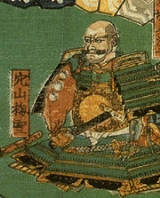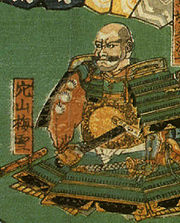
Anayama Nobukimi
Encyclopedia

, also known as Baisetsu Nobukimi, was a Japanese samurai. He was the son of Anayama Nobutomo
Anayama Nobutomo
was a Japanese samurai of the Sengoku period. He was the on of Anayama Nobutsuna. Nobutomo served the Takeda clan of Kai Province and held the title of . He enjoyed special status in the Takeda retainer band due to his marriage to Takeda Nobutora's daughter. Nobutomo fought with distinction during...
and a nephew of Takeda Shingen
Takeda Shingen
, of Kai Province, was a preeminent daimyo in feudal Japan with exceptional military prestige in the late stage of the Sengoku period.-Name:Shingen was called "Tarō" or "Katsuchiyo" during his childhood...
. He became famous as one the Twenty-Four Generals of Takeda Shingen
Twenty-Four Generals of Takeda Shingen
The Twenty-Four Generals were just one of many historically famous groupings of battle commanders from Japan's Sengoku Period. These Twenty-Four were the most trusted commanders of the armies of Takeda Shingen...
.
He fought for his uncle at the Battle of Kawanakajima (1561), the Battle of Mikatagahara
Battle of Mikatagahara
The ' was one of the most famous battles of Takeda Shingen's campaigns, and one of the best demonstrations of his cavalry-based tactics.-Background:...
(1573), and the Battle of Nagashino
Battle of Nagashino
The ' took place in 1575 near Nagashino Castle on the plain of Shitaragahara in the Mikawa province of Japan. Forces under Takeda Katsuyori had besieged the castle since the 17th of June; Okudaira Sadamasa , a Tokugawa vassal, commanded the defending force...
before defecting to the service of Tokugawa Ieyasu
Tokugawa Ieyasu
was the founder and first shogun of the Tokugawa shogunate of Japan , which ruled from the Battle of Sekigahara in 1600 until the Meiji Restoration in 1868. Ieyasu seized power in 1600, received appointment as shogun in 1603, abdicated from office in 1605, but...
, aiding him in his campaign against Takeda Katsuyori
Takeda Katsuyori
was a Japanese daimyo of the Sengoku Period, who was famed as the head of the Takeda clan and the successor to the legendary warlord Takeda Shingen. He was the son of Shingen by the , the daughter of Suwa Yorishige...
. He was rewarded by Tokugawa with a fief in Kai Province
Kai Province
, also known as , is an old province in Japan in the area of Yamanashi Prefecture. It lies in central Honshū, west of Tokyo, in a landlocked mountainous region that includes Mount Fuji along its border with Shizuoka Prefecture....
for his service, but was killed by Takeda sympathizers soon afterwards.
He was given a castle at Ejiri and land in Suruga province after it was taken by Takeda Shingen
Takeda Shingen
, of Kai Province, was a preeminent daimyo in feudal Japan with exceptional military prestige in the late stage of the Sengoku period.-Name:Shingen was called "Tarō" or "Katsuchiyo" during his childhood...
in 1569, and remained there for a decade. He maintained an important place in the Takeda hierarchy under Takeda Katsuyori
Takeda Katsuyori
was a Japanese daimyo of the Sengoku Period, who was famed as the head of the Takeda clan and the successor to the legendary warlord Takeda Shingen. He was the son of Shingen by the , the daughter of Suwa Yorishige...
, and led a large body of troops at the Battle of Nagashino
Battle of Nagashino
The ' took place in 1575 near Nagashino Castle on the plain of Shitaragahara in the Mikawa province of Japan. Forces under Takeda Katsuyori had besieged the castle since the 17th of June; Okudaira Sadamasa , a Tokugawa vassal, commanded the defending force...
in 1575. He appeared to have had some falling out with Katsuyori, and this may have influenced his decision to betray the Takeda clan and join Tokugawa Ieyasu
Tokugawa Ieyasu
was the founder and first shogun of the Tokugawa shogunate of Japan , which ruled from the Battle of Sekigahara in 1600 until the Meiji Restoration in 1868. Ieyasu seized power in 1600, received appointment as shogun in 1603, abdicated from office in 1605, but...
even before the issue was decided. His change of allegiance was fleeting, however. Just a few months later, he accompanied Tokugawa to the capital region and was forced to flee when Akechi Mitsuhide
Akechi Mitsuhide
, nicknamed Jūbei or called from his clan name and title, was a samurai who lived during the Sengoku period of Feudal Japan.Mitsuhide was a general under daimyo Oda Nobunaga, although he became infamous for his betrayal in 1582, which led to Nobunaga's death at Honno-ji...
rebelled. He took a different route home than Ieyasu and the others, and was killed. One legend has it that vengeful Takeda men had committed the murder after tracking him for weeks. He had one son, Anayama Nobukimi, who lived for just fifteen years, 1572 to 1587.

